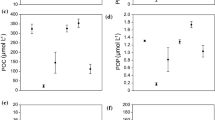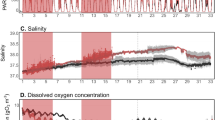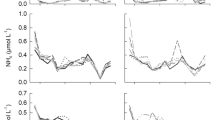Abstract
Decreasing biodiversity is projected as one of the most consistent effects of warming on marine microbial communities. It is predicted that low biodiversity will consequently influence the community sensitivity to additional environmental alterations. Mesocosms were used to study the response of natural Mediterranean phytoplankton communities (control and heat shock + 6 °C) to salinity variations (− 5psu, control, + 5psu). We examined the effect on species composition, species richness as well as phytoplankton biomass and resource use efficiency. Heat shock was coupled with decreased species richness (30 species in control community while 26 in heat shock) and slightly reduced phytoplankton biomass. Changes in salinity altered the phytoplankton species composition (dinoflagellates were absent in decreased salinity treatments) and significantly reduced the phytoplankton species richness. The phytoplankton biomass and the resource use efficiency also decreased with exception of the increased salinity treatment in the non-heated community. In general, decreased salinity had stronger negative effects compared to increased salinity as displayed by the lowest species richness and lowest phytoplankton biomass in those treatments. Most notably, we identified a synergistic negative effect of heat shock with increased/decreased salinity which can be attributed to the lower species richness and, thus, decreased stability in the heated community.





Similar content being viewed by others
References
Andrews J (1998) Bacteria as modular organisms. Annu Rev Microbiol 52:105–126
Araújo MB, Rahbek C (2006) How does climate change affect biodiversity? Science 313(5792):1396–1397
Band-Schmidt CJ, Morquecho L, Lechuga-Devéze CH, Anderson DM (2004) Anderson Effects of growth medium, temperature, salinity and seawater source on the growth of Gymnodinium catenatum (Dinophyceae) from Bahia Concepcíon, Gulf of California, Mexico. J Plankton Res 26:1459–1470
Belkin N, Rahav E, Elifantz H, Kress N, Berman-Frank I (2015) Enhanced salinities, as a proxy of seawater desalination discharges, impact coastal microbial communities of the eastern Mediterranean Sea. Environ Microbiol 17:4105–4120
Bellard C, Bertelsmeier C, Leadley P, Thuiller W, Courchamp F (2012) Impacts of climate change on the future of biodiversity. Ecol Lett 15:365–377
Boyce DG, Lewis MR, Worm B (2010) Global phytoplankton decline over the past century. Nature 466(7306):591–596
Boyd PW, Collins S, Dupont S et al (2018) Experimental strategies to assess the biological ramifications of multiple drivers of global ocean change—a review. Glob Change Biol 00:1–23
Brown EJ, Button DK, Lang DS (1981) Competition between heterotrophic and autotrophic microplankton for dissolved nutrient. Microb Ecol 7:199–206
Burgmer T, Hillebrand H (2011) Temperature mean and variance alter phytoplankton biomass and biodiversity in a long-term microcosm experiment. Oikos 120:922–933
Cetinic I, Viličić D, Burić Z, Olujć G (2006) Phytoplankton seasonality in a highly stratified karstic estuary (Krka, Adriatic Sea). Hydrobiologia 555:31–40
Chapin FS, Zavaleta E, Eviner VT et al (2000) Consequences of changing biodiversity. Nature 405:234–242
Chust G, Allen JI, Bopp L et al (2014) Biomass changes and trophic amplification of plankton in a warmer ocean. Glob Change Biol 20:2124–2139
Daufresne M, Lengfellner K, Sommer U (2009) Global warming benefits the small in aquatic ecosystems. Proc Natl Acad Sci USA 106(31):12788–12793
De Senerpont Domis LN, Van de Waal DB, Helmsing NR, Van Donk E, Mooij WM (2014) Community stoichiometry in a changing world: combined effects of warming and eutrophication on phytoplankton dynamics. Ecology 95:1485–1495
Dhib A, Frossard V, Turki S, Aleya L (2013) Dynamics of harmful dinoflagellates driven by temperature and salinity in a northeastern Mediterranean lagoon. Environ Monit Assess 185(4):3369–3382
Doney SC, Ruckelhaus M, Duffy E et al (2012) Climate change impacts on marine ecosystems. Annu Rev Mar Sci 4:11–37
Edwards KF, Thomas MK, Klausmeier CA, Litchman E (2012) Allometric scaling and taxonomic variation in nutrient utilization traits and maximum growth rate of phytoplankton. Limnol Oceanogr 57:554–566
Egge ES, Johannessen TV, Andersen T, Eikrem W, Bittner L, Larsen A, Sandaa R, Edvardsen B (2015) Seasonal diversity and dynamics of haptophytes in the Skagerrak, Norway, explored by high-throughput sequencing. Mol Ecol 24:3026–3042
Feckler A, Goedkoop W, Konschak M et al (2018) History matters: heterotrophic microbial community structure and function adapt to multiple stressors. Glob Change Biol 24:e402–e415
Finkel ZV, Beardall J, Flynn KJ, Quigg A, Rees TAV, Raven JA (2010) Phytoplankton in a changing world: cell size and elemental stoichiometry. J Plankton Res 32(1):119–137
Flöder S, Hillebrand H (2012) Species traits and species diversity affect community stability in a multiple stressor framework. Aquat Biol 17:197–209
Flöder S, Jaschinski S, Wellsa G, Burnsa CW (2010) Dominance and compensatory growth in phytoplankton communities under salinity stress. J Exp Mar Bio Ecol 395(1–2):223–231
Garnier A, Pennekamp F, Lemoine M, Petchey OL (2017) Temporal-scale-dependent interactions between multiple environmental disturbances in microcosm ecosystems. Glob Change Biol 23:5237–5248
Gruner DS, Bracken ME, Berger SA, Eriksson BK, Gamfeldt L, Matthiessen B, Moorthi S, Sommer U, Hillebrand H (2017) Effects of experimental warming on biodiversity depend on ecosystem type and local species composition. Oikos 126:8–17
Gudasz C, Bastviken D, Steger K, Premke K, Sobek S, Tranvik LJ (2010) Temperature-controlled organic carbon mineralization in lake sediments. Nature 466:478–481
Hansen HP, Koroleff F (1999) Determination of nutrients. In: Grasshoff K, Kremling K, Ehrhardt M (eds) Methods of seawater analysis, 3rd edn. Wiley VCH, Weinheim, pp 159–228
Harley CDG, Hughes AR, Hultgren KM et al (2006) The impacts of climate change in coastal marine systems. Ecol Lett 9:228–241
Hernando M, Schloss IR, Malanga G, Almandoz GO, Ferreyra GA, Aguiar MB, Puntarulo S (2015) Effects of salinity changes on coastal Antarctic phytoplankton physiology and assemblage composition. J Exp Mar Bio Ecol 466:110–119
Hillebrand H, Matthiessen B (2009) Biodiversity in a complex world: consolidation and progress in functional biodiversity research. Ecol Lett 12:1405–1419
Hillebrand H, Dürselen C, Kirschtel D, Pollingher U, Zohary T (1999) Biovolume calculation for pelagic and benthic microalgae. J Phycol 35:403–424
Hooper DU, Chapin FS, Ewel JJ et al (2005) Effects of biodiversity on ecosystem functioning: a consensus of currents knowledge. Ecol Monogr 75(1):3–35
Hutchins DA, Fu F (2017) Microorganisms and ocean global change. Nat Microbiol 2:17058
IPCC (2014) Climate change 2014: impacts, adaptation and vulnerability. IPCC Working Group II contribution to the 5th assessment report of the International Panel on Climate Change. Cambridge University Press, Cambridge
Jeffrey SW, Humphrey GF (1975) New spectrophotometric equation for determining chlorophyll a, b, c1 and c2. Biochem Physiol Pflanz 167:194–204
Kaur-Kahlon G, Kumar S, Rehnstam-Holm AS et al (2016) Response of a coastal tropical pelagic microbial community to changing salinity and temperature. Aquat Microb Ecol 77:37–50
Krestenitis NY, Kombiadou KD, Androulidakis YS (2012) Interannual variability of the physical characteristics of North Thermaikos Gulf (NW Aegean Sea). J Mar Syst 96–97:132–151
Lewandowska A, Sommer U (2010) Climate change and the spring bloom: a mesocosm study on the influence of light and temperature on phytoplankton and mesozooplankton. Mar Ecol Prog Ser 405:101–111
Lewandowska MA, Breithaupt P, Hillebrand H, Hoppe HG, Jürgens K, Sommer U (2012) Responses of primary productivity to increased temperature and phytoplankton diversity. J Sea Res 72:87–93
Lewandowska MA, Boyce DG, Hoffman Matthiessen B, Sommer U, Worm B (2014) Effects of sea surface warming on marine plankton. Ecol Lett 17:614–623
López-Urrutia Á, Martin ES, Harris RP, Irigoien X (2006) Scaling the metabolic balance of the oceans. Proc Natl Acad Sci USA 103:8739–8744
Loreau M, Naeem S, Inchausti P et al (2001) Biodiversity and ecosystem functioning: current knowledge and future challenges. Science 294:804–808
Massana R, Logares R (2013) Eukaryotic versus prokaryotic marine picoplankton ecology. Environ Microbiol 15:1254–1261
McQuoid MR (2005) Influence of salinity on seasonal germination of resting stages and composition of microplankton on the Swedish west coast. Mar Ecol Prog Ser 289:151–163
Menden-Deuer S, Lessard EJ (2000) Carbon to volume relationships for dinoflagellates, diatoms, and other protist plankton. Limnol Oceanogr 45:569–579
Mihalatou HM, Moustaka-Gouni M (2002) Pico-, Nano-, microplankton abundance and primary productivity in a eutrophic coastal area of the Aegean sea. Mediterr Int Rev Hydrobiol 87:439–456
Najdek M, Blažina M, Djakovac T, Kraus R (2005) The role of the diatom Cylindrotheca closterium in a mucilage event in the northern Adriatic Sea: coupling with high salinity water intrusions. J Plankton Res 27(9):851–862
Nikolaides G, Moustaka-Gouni M (1990) The structure and dynamics of phytoplankton assemblages from the inner part of the Thermaikos Gulf, Greece. I. Phytoplankton composition and biomass from May 1988 to April 1989. Helgol. Wiss. Meeresunters 44(3):487–501
O’Connor MI, Piehler MF, Leech DM, Anton A, Bruno JF (2009) Warming and resource availability shift food web structure and metabolism. PLoS Biol 7:1–6
Paul C, Sommer U, Garzke J, Moustaka-Gouni M, Paul A, Matthiensen B (2016) Effects of increased CO2 concentration on nutrient limited coastal summer plankton depend on temperature. Limnol Oceanogr 61:853–868
Pilkaitytë R, Schoor A, Schubert H (2004) Response of phytoplankton communities to salinity changes-a mesocosm approach. Hydrobiologia 513:27–38
Pimm S, Russel GJ, Gittleman JL, Brooks TM (1995) The future of biodiversity. Science 269:347–350
Porter KG, Feig YS (1980) The use of DAPI for identifying and counting aquatic microflora. Limnol Oceanogr 25:943–948
Ptacnik R, Solimini AG, Andersen T, Tamminen T, Brettum P, Lepistö L, Willén E, Rekolainen S (2008) Diversity predicts stability and resource use efficiency in natural phytoplankton communities. Proc Natl Acad Sci USA 105:5134–5138
Quigg A, Finkel Z, Irwin AJ et al (2003) The evolutionary inheritance of elemental stoichiometry in marine phytoplankton. Nature 425:291–294
Remy M, Hillebrand H, Flöder S (2017) Stability of marine phytoplankton communities facing stress related to global change: interactive effects of heat waves and turbidity. J Exp Mar Bio Ecol 497:219–229
Reshef D, Reshef YA, Finucane HK, Grossman SR, McVean G, Turnbaugh PJ, Lander ES, Mitzenmacher M, Sabeti PC (2011) Detecting novel associations in large data sets. Science 334:1518–1524
Simboura N, Pavlidou A, Bald J, Tsapakis M, Pagou K, Zeri Ch, Androni A, Panayotidis P (2016) Response of ecological indices to nutrient and chemical contaminant stress factors in Eastern Mediterranean coastal waters. Ecol Indic 70:89–105
Smoot ME, Ono K, Ruscheinski J, Wang PL, Ideker T (2011) Cytoscape 2.8: new features for data integration and network visualization. Bioinformatics 27:431–432
Sommer U, Lengfellner K, Lewandowska A (2012a) Experimental induction of a coastal spring bloom early in the year by intermittent high-light episodes. Mar Ecol Prog Ser 446:61–71
Sommer U, Adrian R, Bauer B, Winder M (2012b) The response of temperate aquatic ecosystems to global warming: novel insights from a multidisciplinary project. Mar Biol 159(11):2367–2377
Sommer U, Peter KH, Genitsaris S, Moustaka-Gouni M (2016) Do marine phytoplankton follow Bergmann’s rule sensu lato? Biol Rev 92:1011–1026
Tatters AO, Schnetzer A, Xu K et al (2018) Interactive effects of temperature, CO2 and nitrogen source on a coastal California diatom assemblage. J Plankton Res 40(2):151–164
Tilman D (1977) Resource competition between plankton algae: an experimental and theoretical approach. Ecology 58:338–348
Vallina SM, Follows MJ, Dutkiewicz S, Montoya JM, Cermeno P, Loreau M (2014) Global relationship between phytoplankton diversity and productivity in the ocean. Nat Commun 5:4299
Vidussi F, Mostajir B, Fouilland E, Le Floc’h E, Nouguier J, Roques C, Got P, Thibault-Botha D, Bouvier T, Troussellier M (2011) Effects of experimental warming and increased ultraviolet B radiation on the Mediterranean plankton food web. Limnol Oceanogr 56(1):206–218
Vinebrooke RD, Cottingham KL, Norberg J, Scheffer M, Dodson SI, Maberly SC, Sommer U (2004) Impacts of multiple stressors on biodiversity and ecosystem functioning: the role of species co-tolerance. Oikos 104:451–457
Wijffels S, Roemmich D, Monselesan D, Church J, Gilson J (2016) Ocean temperatures chronicle the ongoing warming of Earth. Nat Clim Change 6(2):116–118
Yvon-Durocher G, Jones JI, Trimmer M, Woodward G, Montoya JM (2010) Warming alters the metabolic balance of ecosystems. Philos Trans R Soc Lond B Biol Sci 365(1549):2117–2126
Yvon-Durocher G, Schaum CE, Trimmer M (2017) The temperature dependence of phytoplankton stoichiometry: investigating the roles of species sorting and local adaptation. Front Microbiol 8:2003
Acknowledgments
T. Hansen, B. Gardeler and C. Meyer are gratefully acknowledged for possessing the flow cytometry and the nutrients data. The experiments are part of the BEN-Network (non-random biodiversity experiments network) initiated by A.M. Lewandowska (University of Helsinki, Tvärminne Zoological Station). Similar experiments using the same design are being conducted on other marine sites. We would like to thank two anonymous reviewers for helping improve our manuscript.
Funding
This research is implemented through IKY scholarships program and co-financed by the European Union (European Social Fund–ESF) and Greek national funds through the action entitled” Scholarships program for postgraduates studies-2nd Study Cycle” in the framework of the Operational Program “Human Resources Development Program, Education and Lifelong Learning” of the National Strategic Reference Framework (NSRF) 2014–2020.
Author information
Authors and Affiliations
Corresponding author
Ethics declarations
Conflict of interest
The authors declare that they have no conflict of interest.
Human and animal rights statement
This article does not contain any studies with human participants or animals performed by any of the authors.
Additional information
Responsible Editor: N. Aberle-Malzahn.
Revieved by Undisclosed experts.
Electronic supplementary material
Below is the link to the electronic supplementary material.
Rights and permissions
About this article
Cite this article
Stefanidou, N., Genitsaris, S., Lopez-Bautista, J. et al. Effects of heat shock and salinity changes on coastal Mediterranean phytoplankton in a mesocosm experiment. Mar Biol 165, 154 (2018). https://doi.org/10.1007/s00227-018-3415-y
Received:
Accepted:
Published:
DOI: https://doi.org/10.1007/s00227-018-3415-y




